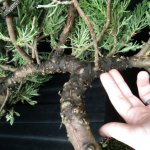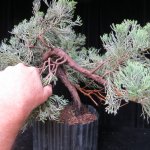A Random User
Guest
- Messages
- 3,554
- Reaction score
- 4,277
First off, let me apologize for the photos not being so great... had to use the flash seeing that it is getting dark. In the following photographs one will see that I have stripped the bottom branch of all foliage and for the moment have just left it as is... will have bark removed, and shortened.
So, let's go through the issues the tree has in order to find a path forward.
First off one will notice that right at the very base of the trunk one will see there is a bend. Now, I will be able to remove some of the soil beneath it and expose some trunk below this bend... However, right of the bat this feature limits how one can change the angle of the tree in the planting, seeing that if in the first two photos one tries to tilt to the left, you will be burying the trunk down in the soil, which we don't want to do. So, already we have one decision made for us... The tree's angle must either remain the same, or must be tilted to the right.
First branch is going to be jined as previously mentioned. The trunk then goes up, and bam... we have a dead end with the trunk splitting off, quite literally making a "T". If this was not bad enough, both are of really thick in diameter, and are equal in size. Often, in a situation such as this one might be able to use one as a branch, and the other the actual further continuation of the trunk. But, ideally what one would prefer in a scenario such as that would be varying sizes between the two, the smaller becoming the branch, as well as the one becoming the branch not being so thick in size. A branch to thick, means it limits amount of movement one can do, as well as visually needs to taper down and work within the design of the tree, as well as the look of the rest of the tree's branching. If all the tree has smaller branching and then one has this one branch 3 x that of the others... it looks kinda weird and wrong.
So... this point is going to be so far the most determining feature of where and how to move forward with the tree. If one cannot figure out a way to make them both work... then one needs to be removed.
In my next post, I will discuss the pros and cons of each path forward, in the hopes of trying to find the path forward with establishing the style of the tree. Thanks!
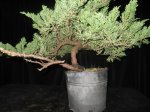
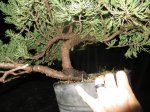
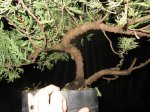
So, let's go through the issues the tree has in order to find a path forward.
First off one will notice that right at the very base of the trunk one will see there is a bend. Now, I will be able to remove some of the soil beneath it and expose some trunk below this bend... However, right of the bat this feature limits how one can change the angle of the tree in the planting, seeing that if in the first two photos one tries to tilt to the left, you will be burying the trunk down in the soil, which we don't want to do. So, already we have one decision made for us... The tree's angle must either remain the same, or must be tilted to the right.
First branch is going to be jined as previously mentioned. The trunk then goes up, and bam... we have a dead end with the trunk splitting off, quite literally making a "T". If this was not bad enough, both are of really thick in diameter, and are equal in size. Often, in a situation such as this one might be able to use one as a branch, and the other the actual further continuation of the trunk. But, ideally what one would prefer in a scenario such as that would be varying sizes between the two, the smaller becoming the branch, as well as the one becoming the branch not being so thick in size. A branch to thick, means it limits amount of movement one can do, as well as visually needs to taper down and work within the design of the tree, as well as the look of the rest of the tree's branching. If all the tree has smaller branching and then one has this one branch 3 x that of the others... it looks kinda weird and wrong.
So... this point is going to be so far the most determining feature of where and how to move forward with the tree. If one cannot figure out a way to make them both work... then one needs to be removed.
In my next post, I will discuss the pros and cons of each path forward, in the hopes of trying to find the path forward with establishing the style of the tree. Thanks!




